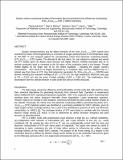| dc.contributor.author | Kim, Chang Sub | |
| dc.contributor.author | Bishop, Sean | |
| dc.contributor.author | Perry, Nicola | |
| dc.contributor.author | Tuller, Harry L | |
| dc.date.accessioned | 2017-04-07T20:04:59Z | |
| dc.date.available | 2017-11-05T05:00:05Z | |
| dc.date.issued | 2017-01 | |
| dc.date.submitted | 2016-05 | |
| dc.identifier.issn | 1385-3449 | |
| dc.identifier.issn | 1573-8663 | |
| dc.identifier.uri | http://hdl.handle.net/1721.1/107976 | |
| dc.description.abstract | Oxygen nonstoichiometry and the defect chemistry of the SrSn[subscript 1-x]Fe[subscript x]O[subscript 3-x/2+δ] (SSF) system were examined by means of thermogravimetry as a function of oxygen partial pressure in the temperature range of 700–1000 °C and compared against the corresponding mixed ionic-electronic conducting titanate, SrTi[subscript 1-x]Fe[subscript x]O[subscript 3-x/2+δ] (STF) system. The alternate B site host cation, Sn, was selected to replicate and extend the STF studies, given its distinct band structure and higher electron mobility associated with its 5s derived conduction band as compared to the 3d nature of the conduction band in the titanate. Though shifted slightly by the larger size of Sn, the defect equilibria – including the oxygen vacancy concentration – were found to be largely dominated by Fe oxidation state, and thus differed only in a limited way from those in STF. Key thermodynamic parameters for SrSn[subscript 0.65]Fe[subscript 0.35]O[subscript 2.825+δ] (SSF35) were derived including the reduction enthalpy (4.137 ± 0.175 eV), the high temperature electronic band gap (1.755 ± 0.015 eV) and the anion Frenkel enthalpy (0.350 ± 0.350 eV). The implications these observations have for cathode behavior in solid oxide fuel cells are briefly discussed. | en_US |
| dc.description.sponsorship | National Science Foundation (U.S.) (award number DMR-1507047) | en_US |
| dc.publisher | Springer US | en_US |
| dc.relation.isversionof | http://dx.doi.org/10.1007/s10832-017-0064-3 | en_US |
| dc.rights | Creative Commons Attribution-Noncommercial-Share Alike | en_US |
| dc.rights.uri | http://creativecommons.org/licenses/by-nc-sa/4.0/ | en_US |
| dc.source | Springer US | en_US |
| dc.title | Electro-chemo-mechanical studies of perovskite-structured mixed ionic-electronic conducting SrSn[subscript 1-x]Fe[subscript x]O[subscript 3-x/2+δ] part I: Defect chemistry | en_US |
| dc.title.alternative | Electro-chemo-mechanical studies of perovskite-structured mixed ionic-electronic conducting SrSn1-xFexO3-x/2+δpart I: Defect chemistry | en_US |
| dc.type | Article | en_US |
| dc.identifier.citation | Kim, Chang Sub, Sean R. Bishop, Nicola H. Perry, and Harry L. Tuller. “Electro-Chemo-Mechanical Studies of Perovskite-Structured Mixed Ionic-Electronic Conducting SrSn1-xFexO3-X/2+δ part I: Defect Chemistry.” Journal of Electroceramics 38, no. 1 (January 11, 2017): 74–80. | en_US |
| dc.contributor.department | MIT Materials Research Laboratory | en_US |
| dc.contributor.department | Massachusetts Institute of Technology. Department of Materials Science and Engineering | en_US |
| dc.contributor.mitauthor | Kim, Chang Sub | |
| dc.contributor.mitauthor | Bishop, Sean | |
| dc.contributor.mitauthor | Perry, Nicola | |
| dc.contributor.mitauthor | Tuller, Harry L | |
| dc.relation.journal | Journal of Electroceramics | en_US |
| dc.eprint.version | Author's final manuscript | en_US |
| dc.type.uri | http://purl.org/eprint/type/JournalArticle | en_US |
| eprint.status | http://purl.org/eprint/status/PeerReviewed | en_US |
| dc.date.updated | 2017-03-21T04:27:54Z | |
| dc.language.rfc3066 | en | |
| dc.rights.holder | Springer Science+Business Media New York | |
| dspace.orderedauthors | Kim, Chang Sub; Bishop, Sean R.; Perry, Nicola H.; Tuller, Harry L. | en_US |
| dspace.embargo.terms | N | en |
| dc.identifier.orcid | https://orcid.org/0000-0002-1989-4281 | |
| dc.identifier.orcid | https://orcid.org/0000-0002-9811-0077 | |
| dc.identifier.orcid | https://orcid.org/0000-0001-8339-3222 | |
| mit.license | OPEN_ACCESS_POLICY | en_US |
| mit.metadata.status | Complete | |
